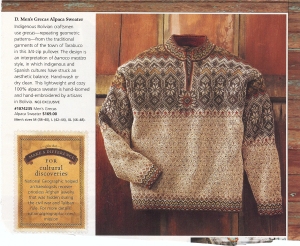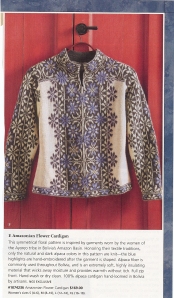I have always admired colorwork. I love the way that the colors blend together in fascinating shades. I love how something so complex and beautiful is made up traditionally of all knit stitches. I love how it makes me thing of mideval tapastries and inflame my romantic side. I do not knit a lot of colorwork projects, however.
It is true that all it requires is following a chart and knitting (most patterns are worked in the round, so you never have to purl). I always seem to have to rip out as much of the project as I knit, though. It seems that I am incapable of following a chart without screwing something up. Often times repeatedly.
2 years ago, I knit all my my children mittens for Christmas. I knit my son a pair of spiderman mittens in a simple chart. I have to tell you I hated those mittens by the time I was done. I ripped out the first one about 3 times because I kept screwing up the simple chart. Then to make matters worse I knit the second mitten exactly like the first, giving me 2 left mittens. All in all, I knit 3 spiderman mittens and I think that was the last colorwork I have done.
A month or so ago was National Alpaca Farm Day. My Grandma came with me and my children to visit a local alpaca farm and to learn a little bit more about the animals. I asked a lot of questions,I must admit, not because I needed to know, but because I wanted my Grandma to know. As a spinner (al be it a novice one) I have done my research and know quite a bit about our wooly friends. My Grandma, though, needs some education. When we first moved in next to her, I talked about sheep, or alpacas and I got the dirtiest look from her. My Grandma is a horse girl. True blue, through and through. I don’t know if she even really acknowledges that other animals exist. She runs a horse boarding facility. Apparently she is concerned that any fiber animal I may decide to raise will not get along with her horses. “Horses don’t like sheep” is all she said.
Today she brought me over a whole fist full of clippings she made out of the National Geographic catalog. “Every one is alpaca!” she said. “They’re really pricy, but so pretty” Before I started knitting, I might have agreed with her, but seriously, $169 for a hand knit fair isle type alpaca sweater? Totally reasonable. After all, it might cost you close to $100 for just the yarn!
I am a knitter, though. I have no intention of purchasing these lovely sweaters. I want to knit them! That’s where the ambition comes in. All of a suddon I have the urge to make a knock off. I want to chart out the patterns and to figure out the construction. Which since I have read Knitting in the Old Way is not too hard.
 This one looks like it could have come straight out of the book. The construction is easy. Knit in the round, steek for the sleeves and the neck. Simple. DH likes the colors and I could see it on him with his sandy blond hair. In reality creaing a knock off hardly presents a challenge (if you ignore my inability to follow a chart), just time consuming since it should probably be knit in fingering weight yarn.
This one looks like it could have come straight out of the book. The construction is easy. Knit in the round, steek for the sleeves and the neck. Simple. DH likes the colors and I could see it on him with his sandy blond hair. In reality creaing a knock off hardly presents a challenge (if you ignore my inability to follow a chart), just time consuming since it should probably be knit in fingering weight yarn.
 This one, though, I covet. I LOVE it. I have not wanted a sweater this much in I don’t know how long. The construction of this one is exactly like the other, knit in the round, steek the sleeves and the front zipper. The description even says that the blue is duplicate stitched on afterward. Simple.
This one, though, I covet. I LOVE it. I have not wanted a sweater this much in I don’t know how long. The construction of this one is exactly like the other, knit in the round, steek the sleeves and the front zipper. The description even says that the blue is duplicate stitched on afterward. Simple.
You’ll notice, though, that there are large white patches at each side. Those beautiful white patches present a problem for me. I can knit in the round, tacking the other colors every few stitches like the philosopher’s wool people teach you, but, well, that is usally visable on the front side in my experiance. I suppose that front panel could be achieved in some form of intarsia, but that is REALLY difficult to do in the round. In my mind I am invisioning some form of a sideways knit sweater. It would be knit in the round with the top and bottom steeked for the hem and neckline. The sides would be sewn up to the armpits and then the sleeves sewn in. Obviously the knitting would hang differently than the one shown since it is oriented differently, but I think if you ignore all the cutting (shudder) it would actually make the whole thing much easier.
Of course, I could also just knit it back and forth in traditional sweater panels which would eliminate the need for all that steeking and would solve the intarsia problem, but then you have to look at the backside and remember to read your chart backwards…
I think I’m overthinking this.
Filed under: Knitting, Knitting Techniques |


Priscilla Gibson-Roberts’ Simple Socks explains several techniques for knitting intarsia in the round without going nuts.
I agree that stranding across the back of those white areas would show through (both a bit of color and some dimpling texture, almost unavoidable)–and would dim the effect of a stunning garment.
For this sweater, I’d go with Priscilla’s “motif knitting” technique, described on page 75 of Simple Socks. It takes a small amount of experimenting to get the hang of doing it, but then it’s really easy and perfectly suited to solving exactly your problem with those white spaces. Work is in the round. All of the pattern rows are set up on the right side of the fabric, so all chart-reading is right-side oriented.
If you don’t have Simple Socks, see if your library or interlibrary loan does.
*GREAT* vision you have there. Would love to see you do this.
Thank you for the recommendation! I will definitely look up the book 🙂